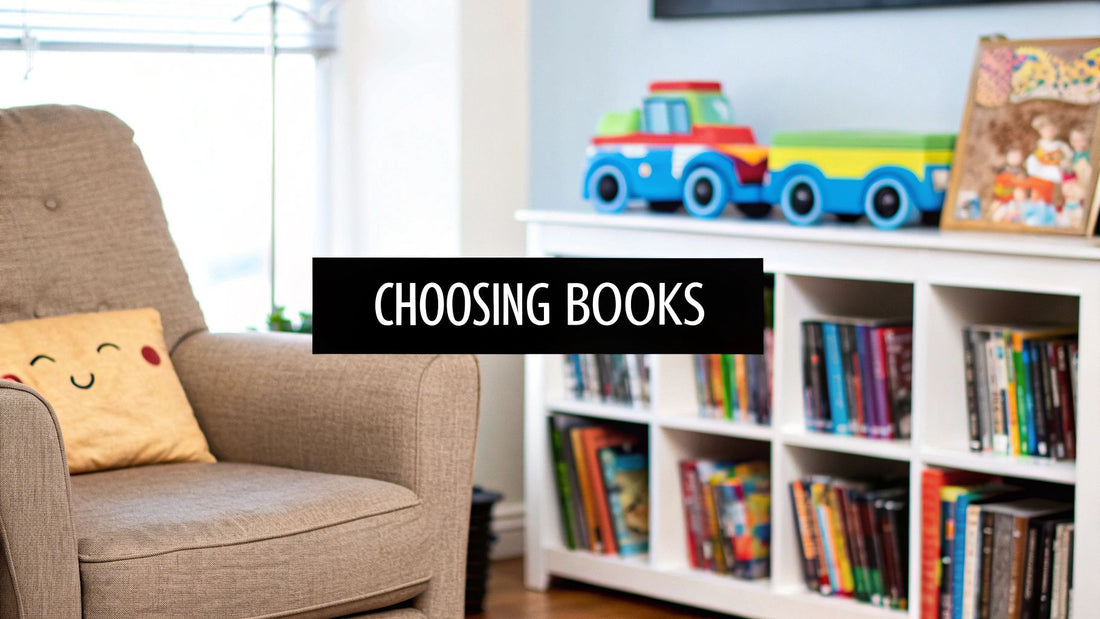
Choosing Books for Autistic Children
Share
Finding the right books for autistic children goes far beyond just picking out a good story. These books are incredible tools for connection, understanding, and emotional growth. For a child who might find the world a bit chaotic, a carefully chosen book offers a predictable and safe way to explore complex feelings, tricky social situations, and new routines, helping them feel seen and a little less alone.
Why Finding the Right Book Is So Important
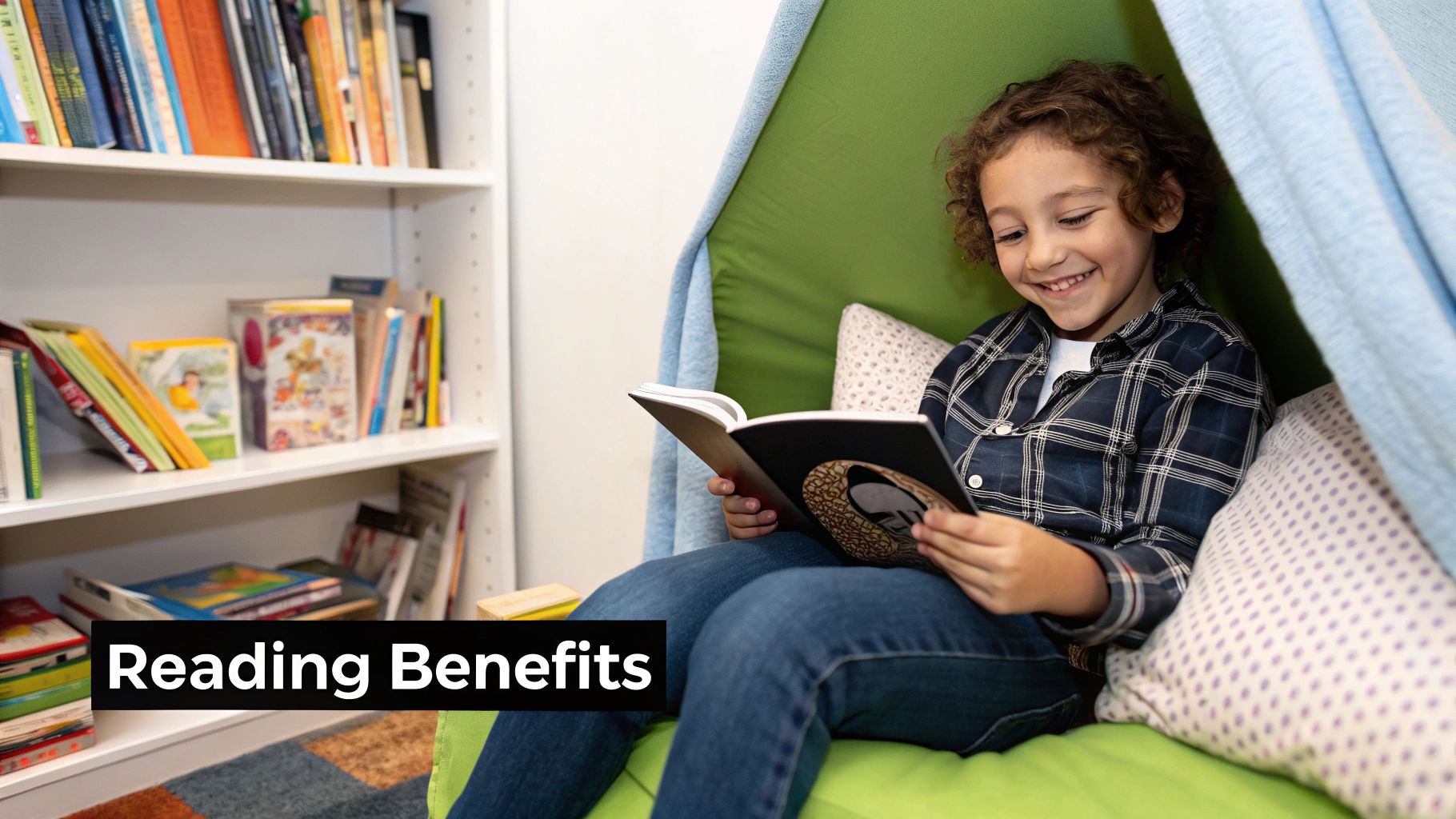
For many autistic children, the world can often feel unpredictable and overwhelming. Books, on the other hand, provide a wonderfully structured, safe space to process information and emotions. A story has a clear beginning, a middle, and an end, and this simple order can be deeply comforting and help dial down anxiety.
When a child sees a character on the page who thinks, feels, or experiences the world in a similar way to them, it's a powerful moment of validation. This kind of representation is absolutely vital for building self-esteem and fostering a positive sense of self, especially as we see mental health challenges among children become more prominent.
Supporting Mental Wellbeing Through Stories
Think of stories as a gentle bridge to understanding a complex social and emotional world. A book can break down a big, scary event—like a first trip to the dentist—into manageable, illustrated steps, making the real-life version feel much less intimidating. This kind of preparation is a practical and powerful way to support a child’s mental wellbeing.
Addressing mental health from an early age is crucial. Poor mental health in childhood can have a lasting impact, and it’s a growing concern in our society. The constant exposure to social media, for instance, can create pressures and anxieties for young people that previous generations never faced. By using books to open up conversations about feelings, we are giving children the tools to navigate these modern challenges.
Looking at the bigger picture, the impact of poor mental health isn't just a personal struggle; it has wider societal costs. For instance, mental health issues cost UK businesses an estimated £56 billion each year in lost productivity and staff turnover. By nurturing emotional literacy from a young age, we’re laying the foundations for a more resilient future generation.
And while choosing the right books is a fantastic start, it's also worth exploring other forms of support, like assistive technology for learning differences, to broaden a child's learning experiences.
A Gentle Disclaimer
I want to be really clear that I am not a mental health professional. The advice and insights I'm sharing here come from experience and research, but they're for informational purposes only. If you have serious concerns about your child's mental health or wellbeing, it is so important to seek help from a doctor or a qualified specialist who can offer professional guidance.
Finding the right book is about so much more than just reading. It's about finding a key that unlocks understanding, fosters connection, and quietly builds a child’s confidence to navigate the world.
There are so many resources out there, from mental health apparel that promotes positive messages to a growing library of mental health books written specifically to tackle big emotions. The goal is always to create a supportive environment where our children feel safe enough to learn, grow, and just be themselves.
How to Choose a Truly Great Book
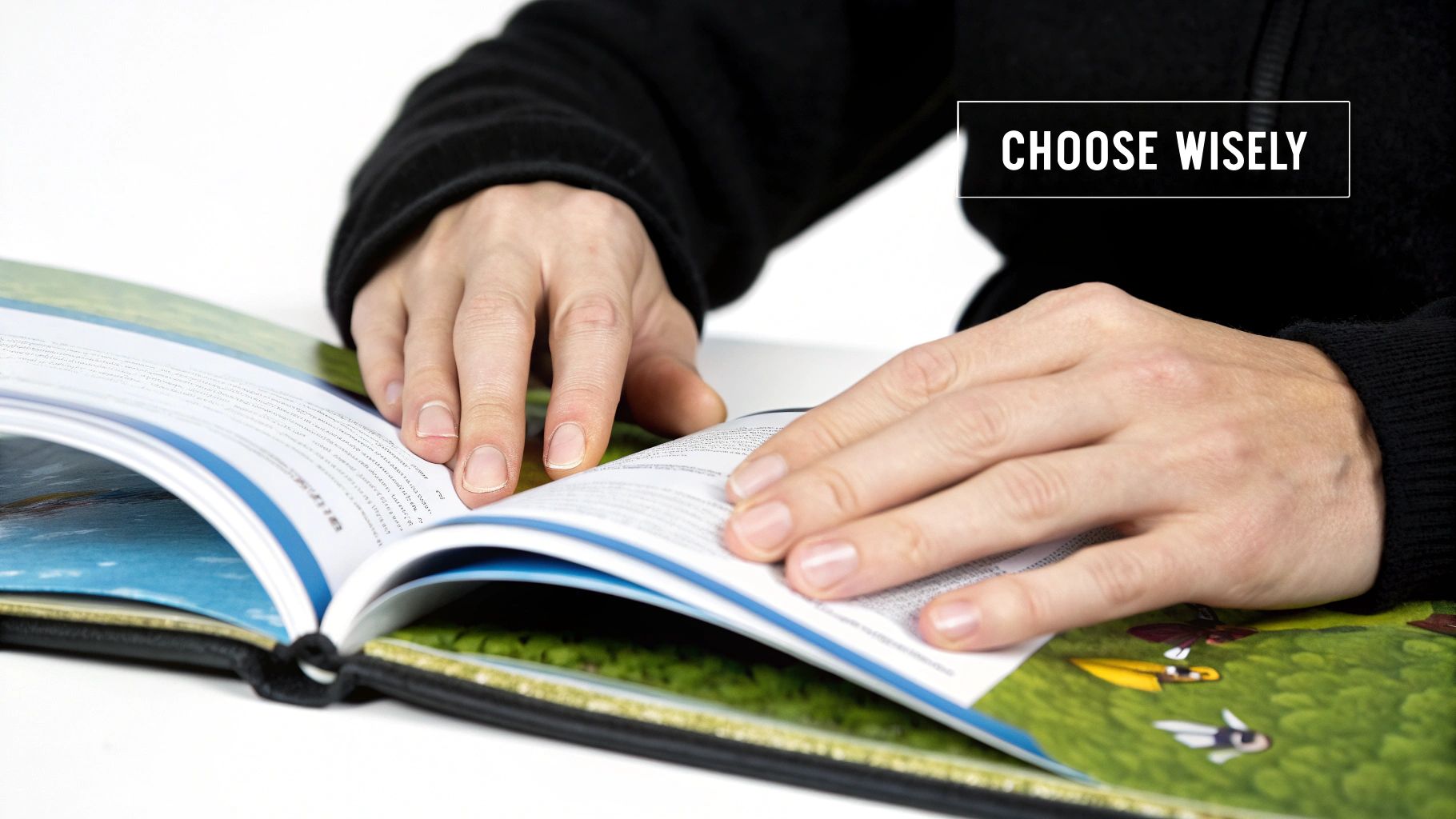
When it comes to choosing the right books for autistic children, it’s not about grabbing the latest bestseller. It’s about finding a story that fits comfortably into your child’s world – something that feels safe, predictable, and genuinely joyful.
A fantastic place to start is with books that use clear, literal language. Many autistic children think very directly, so metaphors and flowery idioms can feel like a confusing puzzle. Simple, straightforward sentences let them get right to the heart of the story without getting tripped up.
It’s the same with predictable plots. Stories with repetitive phrases or familiar routines are incredibly comforting. For instance, a book where the character follows the same bedtime ritual every night can be very calming. Knowing exactly what’s coming next helps lower anxiety and makes the whole experience much more relaxing and fun.
Focus on Visuals and Interests
Illustrations can make or break a book. You'll want to look for pictures that clearly back up the words on the page, showing what’s happening without being too abstract or cluttered. Pages that are too visually 'busy' can be a sensory overload for some kids, so clean, simple artwork is often the way to go.
Honestly, one of the best tricks in the book is to lean into your child’s special interests. Are they obsessed with trains, dinosaurs, or planets? Find books that dive into those worlds. Tapping into their natural enthusiasm is a brilliant way to get them excited about reading.
This kind of thoughtful approach is so important. In the UK, reports have shown that only a quarter of autistic pupils feel happy at school. With over 700,000 people on the autism spectrum in the country, creating positive and engaging learning moments at home matters more than ever. You can read more about this from the National Autistic Society, who do fantastic work highlighting the need for resources that truly connect with autistic children.
Sensory Experience and Social Skills
Don't forget about the physical feel of the book itself. For younger children or those who find comfort in tactile feedback, sensory-friendly books are an absolute game-changer.
- Board Books: They're tough, durable, and easy for little hands to get to grips with.
- Tactile Stories: Books with different textures to feel, flaps to lift, or sounds to press can turn reading into an engaging, multi-sensory adventure.
- Fabric Books: Soft, quiet, and calming, these are perfect for a gentle wind-down story time.
Lastly, think about how a book might gently introduce social skills or emotional ideas. Stories that show characters having conversations, sharing toys, or naming different feelings can be a really effective, low-pressure way to learn. This is something we explore more in our guide on how a children's mental health book can help your child.
The goal isn't just to find a book that’s ‘good for them’. It's to find one that becomes a treasured part of your child’s day. A story they ask for again and again is a story that is truly working, offering both comfort and connection.
Understanding Different Types of Books
The world of children's literature is wonderfully diverse, but certain types of books for autistic children are especially effective. Knowing the different categories helps you choose a story that not only entertains but also supports your child's specific needs—whether that’s learning a new skill or just sharing a moment of joy.
The key is to think about the book’s purpose. Is it to prepare for a new experience, explore a special interest, or provide a comforting, sensory-friendly activity? Each type of book offers a unique set of strengths to meet these different goals.
This infographic gives a simple overview of how you can categorise book choices by age group.
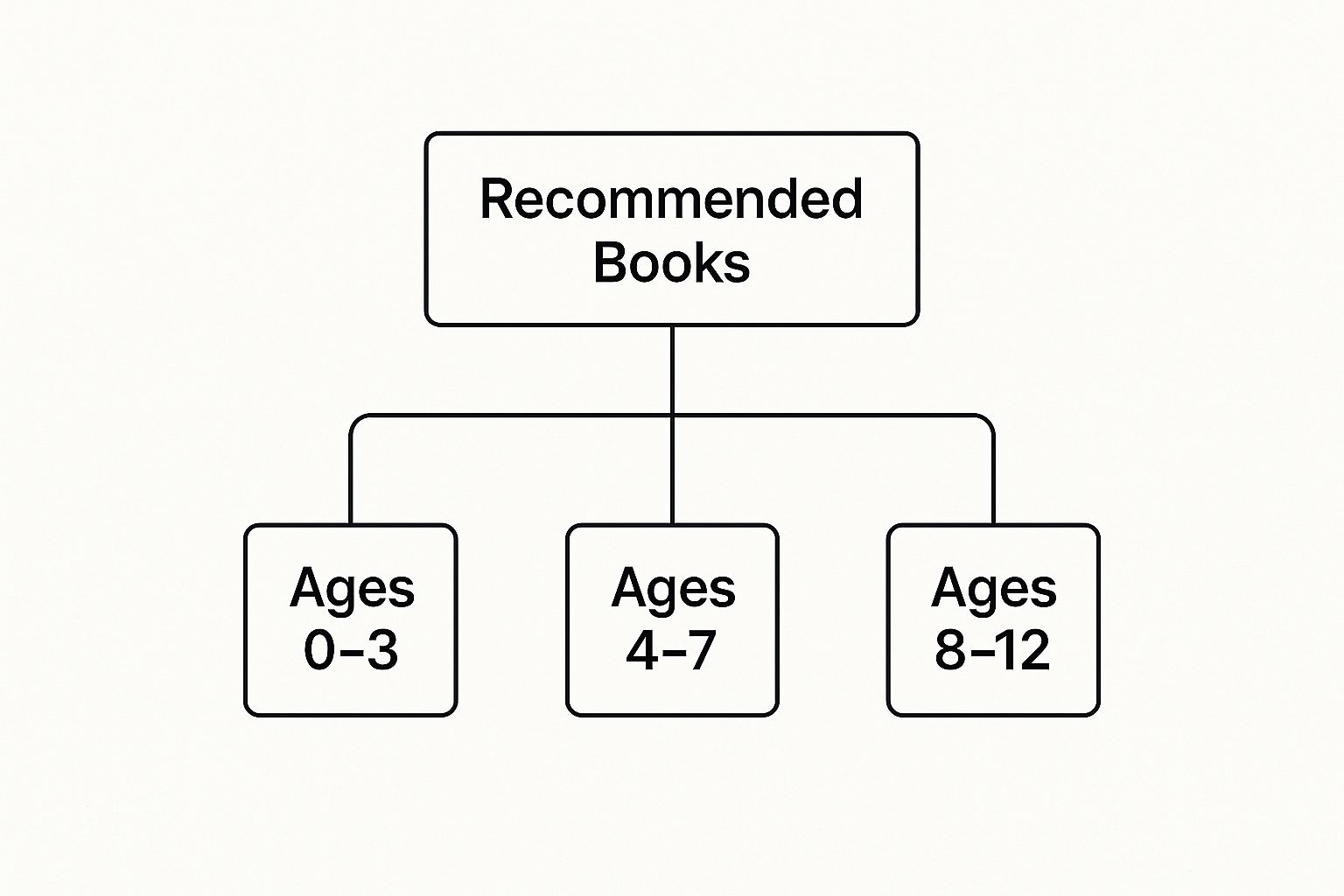
This visual guide is a great starting point for narrowing down the vast options out there, showing how recommendations often line up with different developmental stages.
Social Stories and Skill Building
Social stories are probably one of the most well-known types of books for autistic children. These aren't just stories; they're practical tools written in a clear, literal style to explain a specific social situation or routine. For example, a social story could walk a child through the steps of going to a birthday party, from arriving and giving a present, to playing games and saying goodbye.
These books work by breaking down complex events into predictable, manageable steps, which can really help to reduce anxiety. They give a child a script they can mentally rehearse, making unfamiliar situations feel much safer and more understandable.
Picture and Interactive Books
Strong visual storytelling is incredibly powerful. Picture books with clear, supportive illustrations that directly mirror the text can help children grasp the narrative without having to rely only on words. The images provide essential context and emotional cues that might otherwise be missed.
Interactive books take this a step further by engaging multiple senses.
- Touch-and-Feel Books: These offer tactile stimulation that can be both engaging and calming.
- Lift-the-Flap Books: The element of surprise and discovery turns reading into an exciting game.
- Sound Books: Audio elements can help hold a child's attention and add another layer to the story.
These books are brilliant for turning reading into an active, hands-on experience rather than a passive one. You can learn more about how books can help build these foundational skills in our article on preschool emotions books.
By choosing a book that aligns with how your child experiences the world—whether visually, through touch, or by following a clear sequence—you transform story time from a task into a true connection.
Non-Fiction and Special Interests
Never, ever underestimate the power of a child's special interest. Non-fiction books that dive deep into their favourite topics—be it dinosaurs, train timetables, or ancient Egypt—can be the most engaging books of all. They validate a child's passions and show them that their interests are valuable and worth exploring.
Reading about a beloved topic can boost confidence and foster a genuine love for learning. It provides a fantastic opportunity to introduce new vocabulary and complex ideas within a context that your child already finds fascinating and motivating.
Here’s a quick breakdown of how different book types can support your child's development.
Book Types and Their Benefits for Autistic Children
| Book Type | Primary Benefit | Best For |
|---|---|---|
| Social Stories | Reduces anxiety about new situations by explaining social cues and routines in a literal way. | Preparing for new experiences like a haircut, a doctor's visit, or the first day of school. |
| Picture Books | Provides strong visual context, helping with comprehension and emotional understanding. | Visual learners; developing narrative skills and empathy by connecting text to images. |
| Interactive Books | Engages multiple senses (touch, sound), making reading a hands-on, calming experience. | Sensory seekers; developing fine motor skills and encouraging active participation. |
| Predictable Books | Builds confidence and reduces cognitive load with repetitive text and familiar patterns. | Early readers and children who find comfort in routine and predictability. |
| Non-Fiction Books | Validates a child’s passions and uses their special interests to encourage reading and learning. | Children with deep interests; expanding vocabulary and knowledge on a favourite topic. |
Choosing the right type of book can make all the difference, turning reading into a positive and enriching activity that supports your child exactly where they are.
Practical Strategies for Reading Together
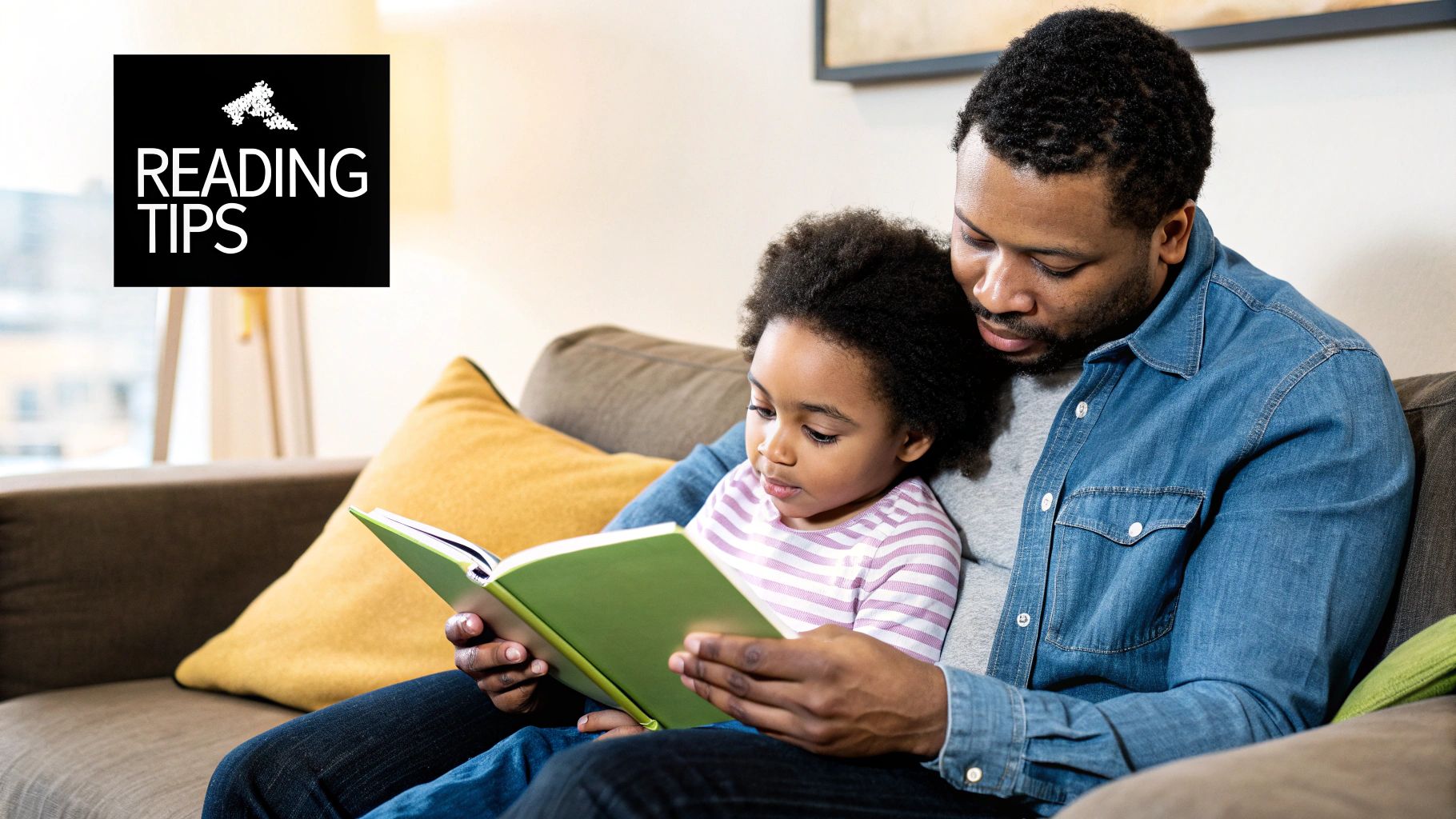
Turning story time into a cherished routine often takes a bit of planning, especially when you’re figuring out the best ways to connect through books for autistic children. The real goal isn't just to get through the words on the page. It's about creating a shared experience that feels calm, connected, and genuinely positive for everyone.
A brilliant first step is to carve out a predictable and comforting reading space. This could be a cosy corner, free from glaring lights, loud noises, or other distractions that might pull focus. By making reading happen at the same time each day, you build a gentle routine your child can look forward to. Simple relaxation techniques, like taking a few deep, slow breaths together before you begin, can also signal that it’s time to wind down and focus.
And most importantly, let your child set the pace. If they want to spend five minutes just looking at one picture or skip ahead to their favourite part, that’s absolutely fine. The focus should always be on the connection you're building, not on finishing the book.
Making the Story Come Alive
Engaging your child with the story is what really makes reading a dynamic, two-way street. A few simple techniques can make a world of difference in helping them connect with the characters and what’s happening.
- Use Expressive Voices: Try varying your tone and pitch for different characters or exciting moments. This adds a fun auditory layer to the story that can really capture their attention.
- Link to Real Life: Gently connect what’s happening in the story to your child's own world. If a character is eating an apple, you could say, "That looks like the yummy red apple you had for your snack today!"
- Ask Simple Questions: Stick to direct, 'who' or 'what' questions about the pictures. Pointing to an image and asking, "What is the dog doing?" is much more accessible than asking abstract questions about how a character feels.
To get these reading strategies right, it helps to understand the bigger picture of support, as this useful case study on supporting individuals with learning difficulties and autism shows.
The Importance of Early Support
These aren't just reading tips; they are powerful forms of early support that help build communication skills and emotional regulation. In the UK, where around 1 in 6 children aged 5 to 16 are identified as having a probable mental health problem, the value of effective, early interventions can't be overstated. Providing tailored educational support, including through shared reading, is a key part of fostering better long-term outcomes.
The most magical moments in reading happen when you stop worrying about getting it 'right' and simply share the joy of a story together, on your child's terms.
By taking these practical steps, you can transform story time from something that might feel stressful into a relaxing, bonding ritual that you and your child will treasure.
Our Top Book Recommendations for Autistic Children
Finding that perfect starting point can feel a bit overwhelming, so I've put together a curated list of fantastic books for autistic children. This isn't just a random collection; it's a selection focused on titles that celebrate neurodiversity, explore big feelings in a clear, gentle way, and sometimes, just offer pure, simple joy.
Think of these recommendations as a friendly launchpad. At the end of the day, the best book is always the one that truly connects with your child's unique personality and sparks their interest.
Books That Celebrate Differences
Some of the most powerful stories are the ones where a child can see themselves reflected positively on the page. These books are wonderful for building self-esteem and showing that being different isn't just okay—it's something to be celebrated.
- "A Friend for Henry" by Jenn Bailey: This gentle story follows a young boy on the autism spectrum as he navigates the sometimes-confusing world of making friends. It’s been widely praised for its authentic and empathetic portrayal of his perspective.
- "All Cats Are on the Autism Spectrum" by Kathy Hoopmann: Using charming cat photos, this book explains autistic traits in a light-hearted and incredibly accessible way. It’s a brilliant tool for helping children, siblings, and even adults understand and appreciate neurodivergent characteristics.
Books for Exploring Emotions
Understanding and naming feelings is a huge part of emotional development for any child. Books that tackle this subject head-on can be incredibly helpful tools, giving you a safe, structured way to talk about big emotions that can otherwise feel abstract and a bit scary.
A story can give a child the language they need to understand their inner world. It provides a map for navigating complex feelings like frustration, happiness, and anxiety, making them feel less overwhelming and more manageable.
For more on this, our guide on unlocking emotional superpowers with an emotions book offers a deeper look at how these stories support a child's mental wellbeing.
Books for Pure Fun and Engagement
Not every book needs to have a deep lesson. Sometimes, the most valuable stories are the ones that are just plain silly, fun, and tap directly into a child's passions. A book about their favourite animal, a fleet of diggers, or a far-off planet can be the most effective way to foster a lifelong love of reading.
- "Press Here" by Hervé Tullet: This interactive book is pure magic without any flaps or tabs. It invites children to press dots, shake the pages, and tilt the book, creating a wonderfully engaging and predictable experience that’s perfect for hands-on readers.
To find more brilliant titles, don't be afraid to visit specialist children's bookshops—the staff are often walking encyclopaedias of recommendations. Online communities and blogs run by autistic advocates and parents are also invaluable resources for finding those tried-and-tested books that really resonate.
Got Questions? We've Got Answers
Stepping into the world of books for autistic children can feel a bit like exploring a new library—exciting, but you might not know where to start. Below are some of the most common questions we hear from parents and carers, with practical advice to help you on your way.
What if My Child Just Isn't Interested in Books?
First off, it's perfectly okay if reading isn't their favourite thing right now. A lack of interest can happen for all sorts of reasons, and the last thing you want is for books to feel like a chore. The real goal is to build a positive, pressure-free connection with stories.
Start small. Create a cosy, sensory-friendly reading corner and keep your reading time short and sweet.
Think about what truly lights them up. Is it trains? Dinosaurs? The solar system? Find books that tap directly into their passions. Interactive books are also a game-changer—ones with textures to feel, flaps to lift, or sounds to press can be far more engaging than a simple story. Audiobooks can be a brilliant bridge, too.
Remember, any positive moment with a story is a win. If they happily flip through a book on their favourite topic for two minutes, that’s a fantastic start. It's about connection, not just finishing the book.
Should I Only Be Using Social Stories?
While social stories are a fantastic tool for preparing for new situations or teaching specific skills, they shouldn't be the only books on the shelf. Just like we all need a balanced diet, a varied reading diet is what helps a genuine love for stories grow.
Books chosen purely for fun are just as important. Stories about their special interests show them that reading can be a relaxing, enjoyable escape. Fictional tales with characters they can relate to are also a gentle, more organic way to build emotional understanding.
The best approach? Mix it up. Weave purposeful books like social stories in with ones that are simply fun and fascinating for your child.
How Can I Find Books with Autistic Characters?
It’s thankfully getting easier to find positive and authentic representation in children's books. A great first stop is the National Autistic Society's website; they often have resource lists and brilliant recommendations. Specialist children's booksellers are also wonderful, as their staff are often incredibly knowledgeable.
You can also search online with phrases like 'neurodivergent characters in kids books' or 'autism representation picture books'. And don't underestimate the power of community! Joining online parent support groups or following autistic advocates on social media is a fantastic way to get tried-and-tested recommendations from other families.
My Child Only Wants to Read the Same Book Over and Over. Should I Worry?
Not at all! This is an incredibly common and reassuring behaviour for many autistic children. There's absolutely no need to worry. Rereading a favourite book offers a deep sense of comfort, predictability, and security in a world that can often feel chaotic.
That repetition allows them to process the story, the language, and the social cues at their own pace, without any jarring surprises. It’s a way for them to really master the content and feel in control.
Instead of trying to stop it, embrace their favourite book as a comforting part of your routine. You could even use it as a gentle launchpad for something new: "After we read your favourite, let's just look at the first page of this new one together." It’s a small step that introduces variety without taking away their source of comfort.
At Little Fish Books, we believe in the power of stories to nurture emotional wellbeing. Our curated collection of books and resources is designed to help children understand their feelings and celebrate their unique perspectives. Explore our range to find the perfect story to connect with your child.
Discover our collection of children’s mental health books at thatsokay.co.uk
